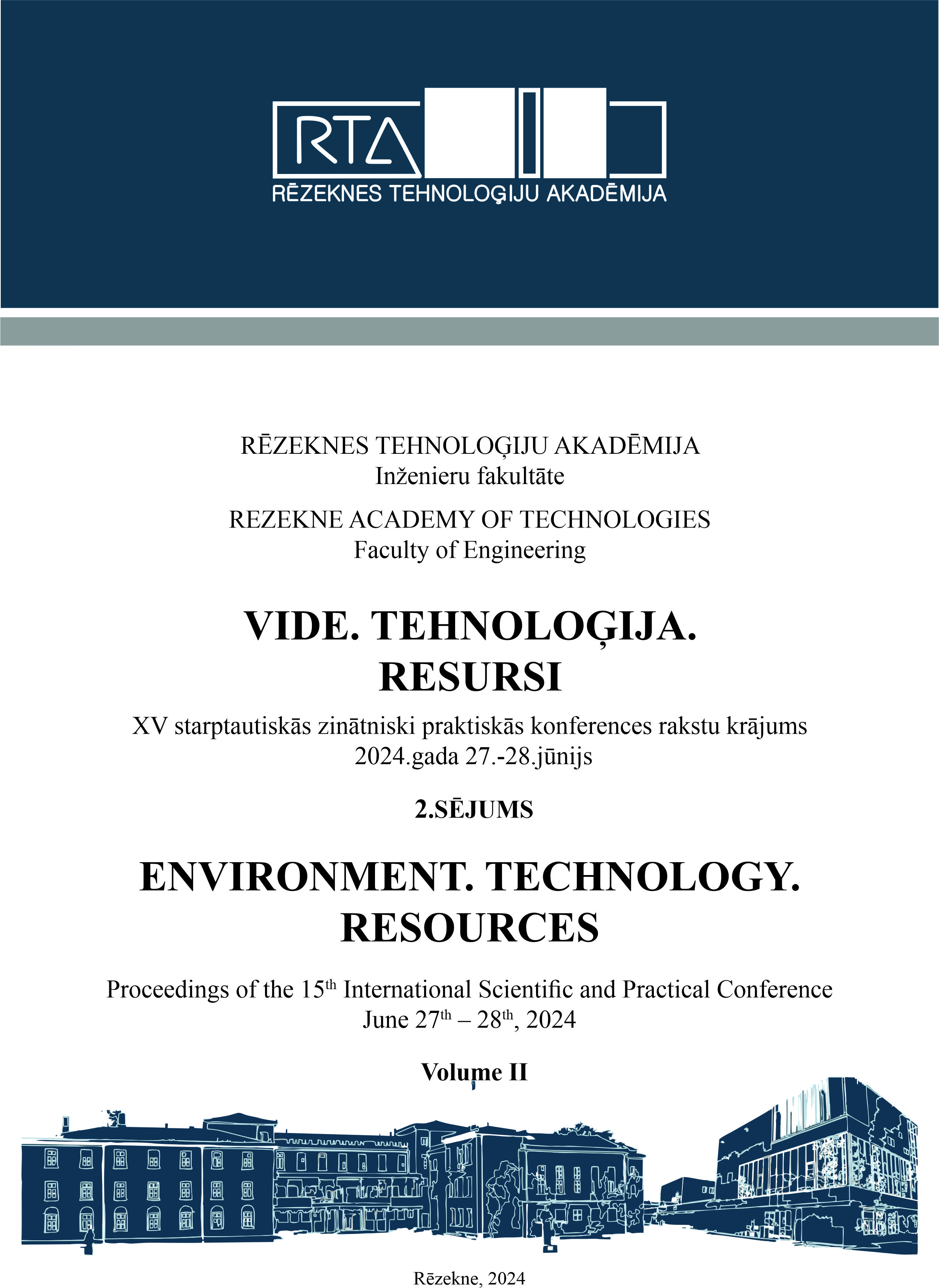TRANSFORMING HIGHER EDUCATION IN THE ERA OF ARTIFICIAL INTELLIGENCE CHAT TOOLS: CASE STUDY
DOI:
https://doi.org/10.17770/etr2024vol2.8014Keywords:
artificial intelligence, AI Chat Tools, transformation, teaching, evaluation, higher educationAbstract
These days it’s hard to find someone who hasn’t heard of Artificial Intelligence (AI). It is a reality of today’s life. Although there are many questions – how to use it effectively, especially in higher education and research. Therefore, the question of AI Literacy becomes relevant, where the key aspects relate to knowledge, skills and psychosocial factors, including a positive attitude towards AI technology and tools. In order to conduct the corresponding transformation of teaching, learning and assessment from the perspective of higher education, the readiness to use AI tools on the example of AI Chat Tools by staff must first be determined. So, within the scope of ERASMUS+ project “DialogEduShift: Transforming Higher Education Teaching and Evaluation Approaches in the Era of AI Chat Tools” the survey was created for cross-country research, including the respondents from the following countries: Poland, Germany, Turkey, Ukraine, Latvia. A comparative analysis of the survey results was then conducted regarding the perspective of three respondent groups: experts in IT field, academician, and university administration. While some questions were specified and intended only for academician.
This article reviews the insights and suggestions gathered during the survey by creating the list of guidelines for effective transformation of teaching and assessment in higher education institutions in the Era of AI Chat Tools. The aim of the article is to determine the AI Literacy of three groups of respondents: IT experts, academician, and university administration who use AI Chat Tools to increase the effectiveness of their work and to summarize the guidelines for updating and renewing teaching and evaluation approaches in higher education institutions by implementing AI Chat Tools. This research is valuable for improving AI Literacy of higher education staff.
References
Betker et al. (2023). Improving Image Generation with Better Captions. [Onlain]. Available: https://cdn.openai.com/papers/dall-e-3.pdf. [Accessed: February 5, 2024]
Cardona,M.A., Rodríguez, R.J., Ishmael, K. (2023). Artificial Intelligence and the Future of Teaching and Learning Insights and Recommendations. Washington DC: U.S. Department of Education, Office of Educational Technology. [Onlain]. Available: https://www2.ed.gov/documents/ai-report/ai-report.pdf [Accessed: January 17, 2024].
Cordeschi, R. (2007). AI TURNS FIFTY: REVISITING ITS ORIGINS. Applied Artificial Intelligence.[Onlain]. Available: https://www.researchgate.net/publication/220355639_AI_turns_fifty_Revisiting_its_origins [Accessed February 8, 2024], doi:DOI: 10.1080/08839510701252304
Crawford, J., Cowling, M. & Allen, K.A. (2023). Leadership is needed for ethical ChatGPT: Character, assessment, and learning using artificial intelligence (AI). Journal of University Teaching & Learning Practice. [Onalin]. Available: https://www.researchgate.net/publication/369112928_Leadership_is_needed_for_ethical_ChatGPT_Character_assessment_and_learning_using_artificial_intelligence_AI [Accessed: February 14, 2024], doi: https://doi.org/10.53761/1.20.3.02
Crompton, H., Burke, D. (2023). Artifcial intelligence in higher education: the state of the feld. International Journal of Educational Technology in Higher Education, 22. [Onlain]. Available: https://www.researchgate.net/publication/370224159_Artificial_intelligence_in_higher_education_the_state_of_the_field [Accessed: January 11, 2024], doi:https://doi.org/10.1186/s41239-023-00392-8
de Sousa et al. (2019). How and where is artificial intelligence in the public sector going? A literature review and research agenda. Government Information Quarterly. [Onlain]. Available: https://www.researchgate.net/publication/334685240_How_and_where_is_artificial_intelligence_in_the_public_sector_going_A_literature_review_and_research_agenda [Accessed December 24, 2023], doi:http://dx.doi.org/10.1016/j.giq.2019.07.004
Gan et al. (2024). Performance of Google bard and ChatGPT in mass casualty incidents triage. The American Journal of Emergency Medicine, 72-78. [Onlain]. Available: https://www.researchgate.net/publication/375072051_Performance_of_Google_bard_and_ChatGPT_in_mass_casualty_incidents_triage [Accessed February 4, 2024], doi:https://doi.org/10.1016/j.ajem.2023.10.034
Maslej et al. (2023). The AI Index 2023 Annual Report. Stanford, CA: AI Index Steering Committee, Institute for Human-Centered AI, Stanford University. [Onlain]. Available: https://aiindex.stanford.edu/wp-content/uploads/2023/04/HAI_AI-Index-Report_2023.pdf [Accessed: February 14, 2024]
McCarthy et al. (1955). A PROPOSAL FOR THE DARTMOUTH SUMMER RESEARCH PROJECT ON ARTIFICIAL INTELLIGENCE. [Onlain]. Available: http://www-formal.stanford.edu/jmc/history/dartmouth/dartmouth.html [Accessed: January 18, 2024].
Rospigliosi, P. (2023). Artificial intelligence in teaching and learning: what questions should we ask of ChatGPT? Interactive Learning Environments, 1-3. [Onlain]. Available: https://www.researchgate.net/publication/368730305_Artificial_intelligence_in_teaching_and_learning_what_questions_should_we_ask_of_ChatGPT [Accessed: February 18, 2024], doi:10.1080/10494820.2023.2180191
Seirawan, Y. (1997). Still No Match for the Human Brain. Communications of the ACM, 40(8). [Onlain]. Available: https://dl.acm.org/doi/pdf/10.1145/257874.257878 [Accessed: Februry, 2024].
Stephens et al. (2023). Battle of the (Chat)Bots: Comparing Large Language Models to Practice Guidelines for Transfusion-Associated Graft-Versus-Host Disease Prevention. Transfusion Medicine Reviews. [Onlain]. Available: https://www.researchgate.net/publication/373254405_Battle_of_the_chatbots_comparing_large_language_models_to_practice_guidelines_for_transfusion-associated_graft-versus-host_disease_prevention [Accessed: February, 2024], doi:https://doi.org/10.1016/j.tmrv.2023.150753
Tayan et al. (2023). Considerations for adapting higher education technology courses for AI large language models: A critical review of the impact of ChatGPT. Machine Learning with Applications 15. [Onlain]. Available: https://www.researchgate.net/publication/375916566_Considerations_for_Adapting_Higher_Education_Technology_Courses_for_AI_Large_Language_Models_A_Critical_Review_of_the_Impact_of_ChatGPT [Accessed: January, 2024], doi:https://doi.org/10.1016/j.mlwa.2023.100513
UNESCO. (2023). ChatGPT and Artificial Intelligence in Higher Education. UNESCO. [Onlain]. Available: https://www.iesalc.unesco.org/wp-content/uploads/2023/04/ChatGPT-and-Artificial-Intelligence-in-higher-education-Quick-Start-guide_EN_FINAL.pdf [Accessed: February, 2024].
UNESCO COMEST. (2019). Preliminary study on the Ethics of Artificial Intelligence. UNESCO. [Onlain]. Available: https://unesdoc.unesco.org/ark:/48223/pf0000367823 [Accessed: January, 2024].
Downloads
Published
Issue
Section
License
Copyright (c) 2024 Olga Vindaca, Anda Abolina, Liga Danilane

This work is licensed under a Creative Commons Attribution 4.0 International License.



